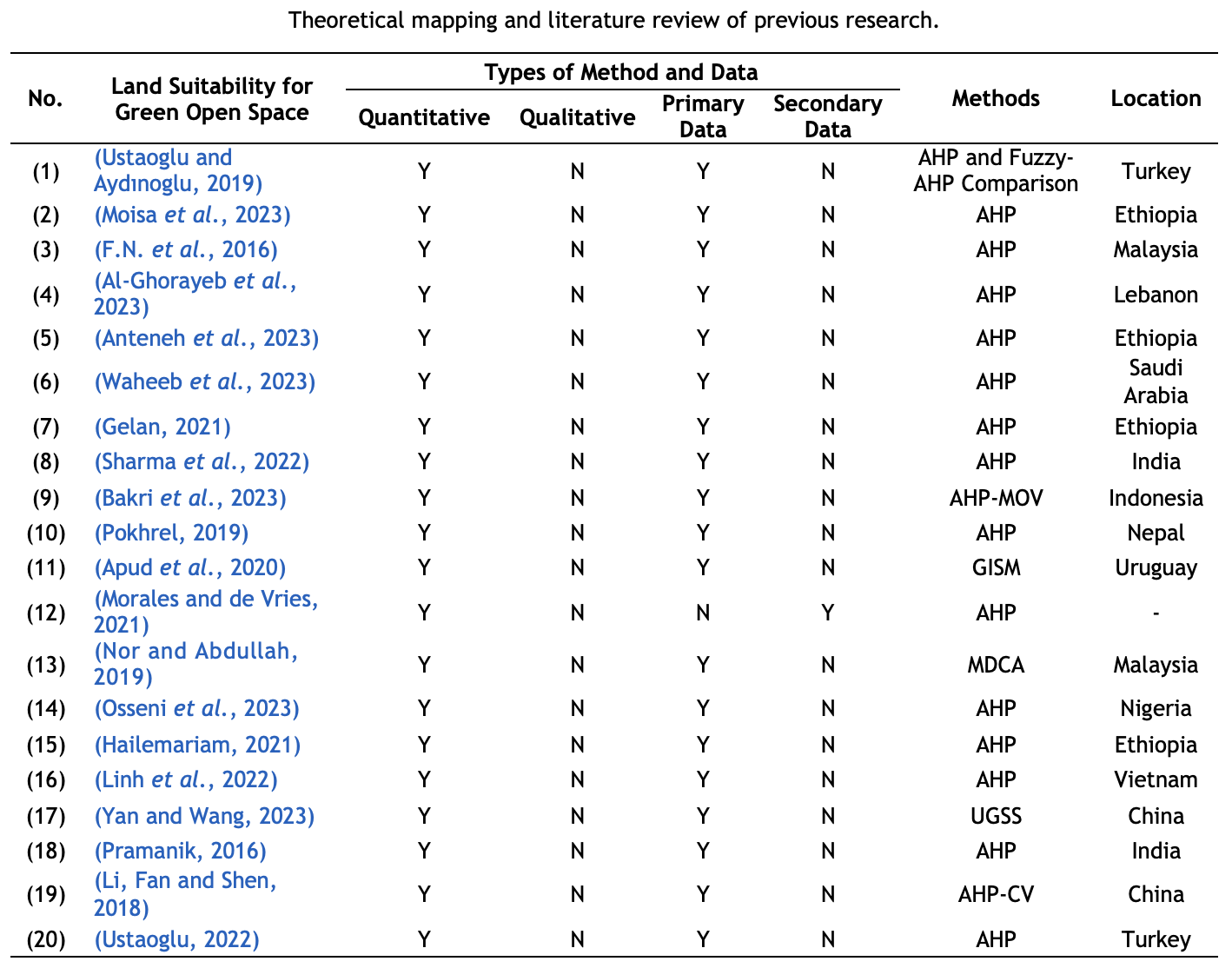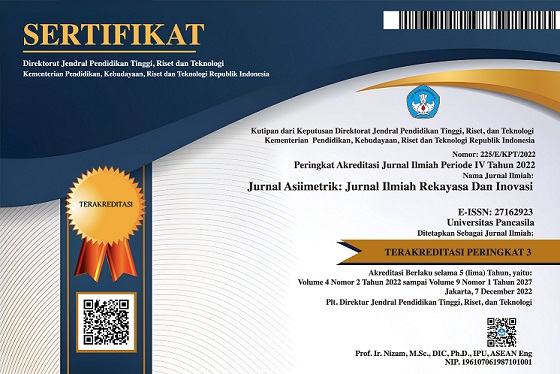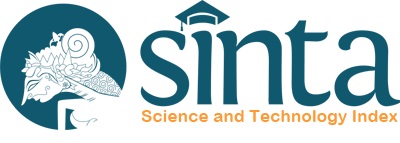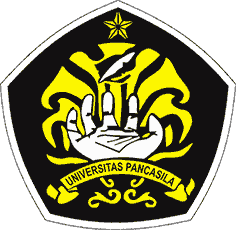Proposing a Land Suitability Analysis Method for Green Open Space in Nusantara Capital City
DOI:
https://doi.org/10.35814/asiimetrik.v7i1.7737Keywords:
Land suitability, green open space, analytical hierarchy process, Nusantara Capital CityAbstract
Green open spaces are regarded as infrastructures that have a major positive impact on urban residents' quality of life and the sustainability of urban growth. Green open spaces play an important role in Nusantara Capital City with the theme of forest city. Examining any techniques employed in earlier research is crucial to determining the accurate location. Understanding the different approaches should enable one to suggest ways for further research in land suitability for green open spaces. We used the literature review of twenty relevant international papers from 2016 to 2023 as our method. In line with previous research, the study's findings show that the analytical hierarchy process is the most popular method employed for land suitability analysis for green open space in Nusantara Capital City. The evaluation criteria that suit Nusantara Capital City are elevation, slope, land use land cover, accessibility, water bodies, and population. The analytical hierarchy process can help further research in land suitability analysis for green open space in Nusantara Capital City.
Downloads
References
Al-Ghorayeb, A. et al. (2023) ‘Land Suitability Analysis for Sustainable Urban Development: A Case of Nabatiyeh Region in Lebanon’, J, 6(2), pp. 267–285. Available at: https://doi.org/10.3390/j6020020.
Anteneh, M.B. et al. (2023) ‘Geospatial Assessment Of Urban Green Space Using Multi-Criteria Decision Analysis In Debre Markos City, Ethiopia’, Environmental Systems Research, 12(1), p. 7. Available at: https://doi.org/10.1186/s40068-023-00291-x.
Apud, A. et al. (2020) ‘Suitability Analysis and Planning of Green Infrastructure in Montevideo, Uruguay’, Sustainability, 12(22), p. 9683. Available at: https://doi.org/10.3390/su12229683.
Bakri, M. et al. (2023) ‘Determining the Location of Public Green Open Space in Kota Palu Using Analytical Hierarchy Process with Map Overlay (AHP-MOV)’, in IOP Conference Series: Earth and Environmental Science. International Conference on Science in Engineering and Technology, Sustainable Environment and Architecture 2022, Palu, Indonesia: IOP Publishing, p. 012045. Available at: https://doi.org/10.1088/1755-1315/1157/1/012045.
Byrne, J., Sipe, N. and Searle, G. (2010) ‘Green Around The Gills? The Challenge Of Density For Urban Greenspace Planning In SEQ’, Australian Planner, 47(3), pp. 162–177. Available at: https://doi.org/10.1080/07293682.2010.508204.
F.N., Rasli. et al. (2016) ‘An Integrated Approach of Analytical Hierarchy Process and GIS for Site Selection of Urban Parks in Iskandar Malaysia.’, International Journal of Geoinformatics, 12(2), pp. 67–77.
Gelan, E. (2021) ‘GIS-based Multi‐Criteria Analysis For Sustainable Urban Green Spaces Planning In Emerging Towns Of Ethiopia: The Case Of Sululta Town’, Environmental Systems Research, 10(1), p. 13. Available at: https://doi.org/10.1186/s40068-021-00220-w.
Hailemariam, B.A. (2021) ‘Suitable Site Selection For Urban Green Space Development Using Geographic Information System And Remote Sensing Based On Multi Criterion Analysis’, International Journal of Human Capital in Urban Management, 6(1), pp. 97–110. Available at: https://doi.org/10.22034/IJHCUM.2021.01.08.
Li, Z., Fan, Z. and Shen, S. (2018) ‘Urban Green Space Suitability Evaluation Based on the AHP-CV Combined Weight Method: A Case Study of Fuping County, China’, Sustainability, 10(8), p. 2656. Available at: https://doi.org/10.3390/su10082656.
Linh, N.H.K. et al. (2022) ‘The Application of Geographical Information Systems and the Analytic Hierarchy Process in Selecting Sustainable Areas for Urban Green Spaces: A Case Study in Hue City, Vietnam’, Climate, 10(6), p. 82. Available at: https://doi.org/10.3390/cli10060082.
Moisa, M.B. et al. (2023) ‘Urban Green Space Suitability Analysis Using Geospatial Techniques: A Case Study Of Addis Ababa, Ethiopia’, Geocarto International, 38(1), p. 2213674. Available at: https://doi.org/10.1080/10106049.2023.2213674.
Morales, F. and de Vries, W.T. (2021) ‘Establishment of Land Use Suitability Mapping Criteria Using Analytic Hierarchy Process (AHP) with Practitioners and Beneficiaries’, Land, 10(3), p. 235. Available at: https://doi.org/10.3390/land10030235.
Nor, A.N.M. and Abdullah, S.A. (2019) ‘Developing Urban Green Space Classification System Using Multi-Criteria: The Case of Kuala Lumpur City, Malaysia’, Journal of Landscape Ecology, 12(1), pp. 16–36. Available at: https://doi.org/10.2478/jlecol-2019-0002.
Osseni, A.A. et al. (2023) ‘GIS-Based Multi-Criteria Analysis for Selecting Suitable Areas for Urban Green Spaces in Abomey-Calavi District, Southern Benin’, Land, 12(8), p. 1553. Available at: https://doi.org/10.3390/land12081553.
Pokhrel, S. (2019) ‘Green Space Suitability Evaluation For Urban Resilience: An Analysis Of Kathmandu Metropolitan City, Nepal’, Environmental Research Communications, 1(10), p. 105003. Available at: https://doi.org/10.1088/2515-7620/ab4565.
Pramanik, M.K. (2016) ‘Site Suitability Analysis For Agricultural Land Use Of Darjeeling District Using AHP And GIS Techniques’, Modeling Earth Systems and Environment, 2(2), p. 56. Available at: https://doi.org/10.1007/s40808-016-0116-8.
Saaty, R.W. (1987) ‘The Analytic Hierarchy Process—What It Is And How It Is Used’, Mathematical Modelling, 9(3), pp. 161–176. Available at: https://doi.org/10.1016/0270-0255(87)90473-8.
Sharma, R. et al. (2022) ‘Urban Green Space Planning and Development in Urban Cities Using Geospatial Technology: A Case Study of Noida’, Journal of Landscape Ecology, 15(1), pp. 27–46. Available at: https://doi.org/10.2478/jlecol-2022-0002.
Sugiyono (2008) Metode Penelitian Pendidikan: (Pendekatan Kuantitatif, Kualitatif Dan R & D). Indonesia: Alfabeta. [Print].
Ustaoglu, E. (2022) ‘An Assessment of Land Use/Cover Suitable for Peri-urban Green Space Development: an Example of an Integration of GIS with the Multi-Criteria Analysis (MCA) Approach’, European Scientific Journal (ESJ), 18(35), pp. 1–27. Available at: https://doi.org/doi.org/10.19044/esj.2022.v18n35p1.
Ustaoglu, E. and Aydınoglu, A.C. (2019) ‘Land Suitability Assessment of Green Infrastructure Development: A Case Study of Pendik District (Turkey)’, TeMA - Journal of Land Use, Mobility and Environment, 12(2), pp. 165–178. Available at: https://doi.org/doi.org/10.6092/1970-9870/6118.
Waheeb, S.A. et al. (2023) ‘Enhancing Sustainable Urban Planning through GIS and Multiple-Criteria Decision Analysis: A Case Study of Green Space Infrastructure in Taif Province, Saudi Arabia’, Water, 15(17), p. 3031. Available at: https://doi.org/10.3390/w15173031.
Yan, G. and Wang, S. (2023) ‘Coexistence And Transformation From Urban Industrial Land To Green Space In Decentralization Of Megacities: A Case Study Of Daxing District, Beijing, China’, Ecological Indicators, 156, p. 111120. Available at: https://doi.org/10.1016/j.ecolind.2023.111120.





























